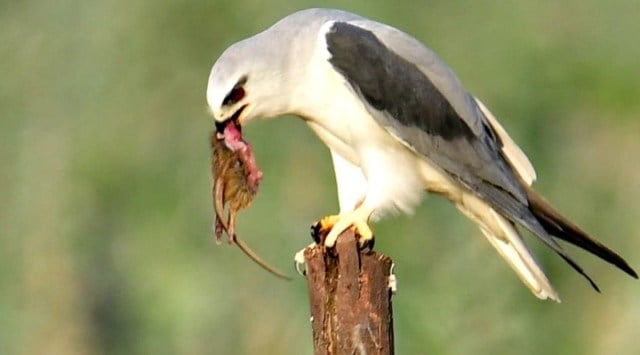Flamingo Gujarat’s special issue highlights diversity of raptors in state
The vulture census conducted last year by the Gujarat Ecological Education and Research (GEER) Foundation, an autonomous body functioning under the forest department, had recorded 713 vultures, more than a third of the 2,143 vultures found across the state.
 A black-shouldered kite in Nalsarovar. Photo courtesy: (Express Photo by Devvratsinh Mori)
A black-shouldered kite in Nalsarovar. Photo courtesy: (Express Photo by Devvratsinh Mori) Weeks after results of a census conducted by the state forest department revealed that the population of vultures has increased, the Bird Conservation Society, Gujarat (BCSG) has come up with Flamingo Gujarat’s special issue dedicated to raptors, the group of birds, which also includes vultures.
This is for the first time that BCSG, the NGO working for conservation of birds, has dedicated an entire issue of its quarterly journal to a group of birds.
The special digital-only issue of Flamingo Gujarat (https://flamingogujarat.com/), published earlier this month, has an article on Egyptian vultures of Banaskantha, written by Suresh Prajapati, an associate professor in the department of zoology at R R Mehta College of Science in Palanpur in collaboration with Kailash Jani, an employee of Banas Dairy.
Reporting their observations between 2006 and 2022, Prajapati writes that he and other birdwatchers observed a congregation of around 600 to 700 Egyptian vultures near Mervada Panjrapole near Palanpur on January 13, 2018. A year earlier, they had recorded a congregation of around 400 to 500 Egyptian vultures at the same sight.
“Our observation shows that the Banaskantha is rich region… (in) Egyptian Vulture population. During winter, the bird count increased largely… during summer and monsoon, its numbers… decreased. Directly or indirectly cattle support… this species. Forest and hilly habitat observed (to be preferable) breeding sites for them,” Prajapati concluded saying the huge dairy industry could be supporting the large number of vultures.
The vulture census conducted last year by the Gujarat Ecological Education and Research (GEER) Foundation, an autonomous body functioning under the forest department, had recorded 713 vultures, more than a third of the 2,143 vultures found across the state. All vultures sighted in Banaskantha during the census exercise were Egyptian vultures.
The census, whose results were submitted to the state government in June, concluded that the vulture population across Gujarat rose by 155 per cent between 2018 and 2022, with the number jumping from a mere 840 to 2,143. The growth was propelled by Egyptian vultures, a species which is both resident and migratory, whose numbers shot up from 148 to 1,258. Population of Indian Vulture also increased from 285 to 362 and that of red-headed vultures from nine to 24. However, the census showed that the population of white-rumped vultures continued to decline and dropped to 283 from 352 in 2018.
In Gujarat, 615 species of birds, including 75 species of raptors, have been recorded. In India, total 557 raptors species have been recorded.
Raju Vyas, a herpetologist and raptor specialist from Vadodara, who has also served as the guest editor of the raptors special issue of Flamingo Gujarat, underlined challenges in vulture conservation in Gujarat. “…in Gujarat, vultures have continued to vanish. In the early 1980s, Indian White-rumped Vultures (Gyps bengalensis) were a common sight, often found soaring in the skies of Gujarat. However, the species is on the verge of extinction four decades later,” he wrote in the editor’s note for the special issue.
The special issue has a research paper authored by Vyas and Devvratsinh Mori, a faculty member at the Ahmedabad University, on breeding ecology of black-shouldered kite, a raptor found across Gujarat. It also has articles on the first known record of laggar falcon in Dang district, an India rock python preying on a mottled owl in Gir forest, an eastern Imperial Eagle preying on a western marsh harrier in the Little Rann of Kutch and a Eurasian hobby being sighted in Bopal of Ahmedabad, among others. Further, the journal has articles on sighting of laggar falcon in Kheda and Anand, sighting of 26 red-necked falcons in one day and record of luggar falcon breeding in Kutch, among others.
Speaking to The Indian Express, Vyas said that though veterinary use of diclofenac drug has been banned in Gujarat after it was identified as the reason for the dip in vulture population, it continues to be used. “This drug is also used for treating humans and therefore it remains available in the market. Therefore, it continues to be used illegally in treating livestock,” he said.
Mori, also the assistant managing editor of Flamingo Gujarat, said that the managing committee of the BCSG decided to come up with a special issue on raptors as western India has rich raptor diversity. “Gujarat and Rajasthan have a rich diversity of raptors, both resident and migratory species. I opined that birdwatchers in Gujarat have knowledge and information about raptors but they have not got a platform to publish them. Therefore, I proposed that we publish a special issue on raptors so that we can know from these birdwatchers from experts who have been studying them.”












